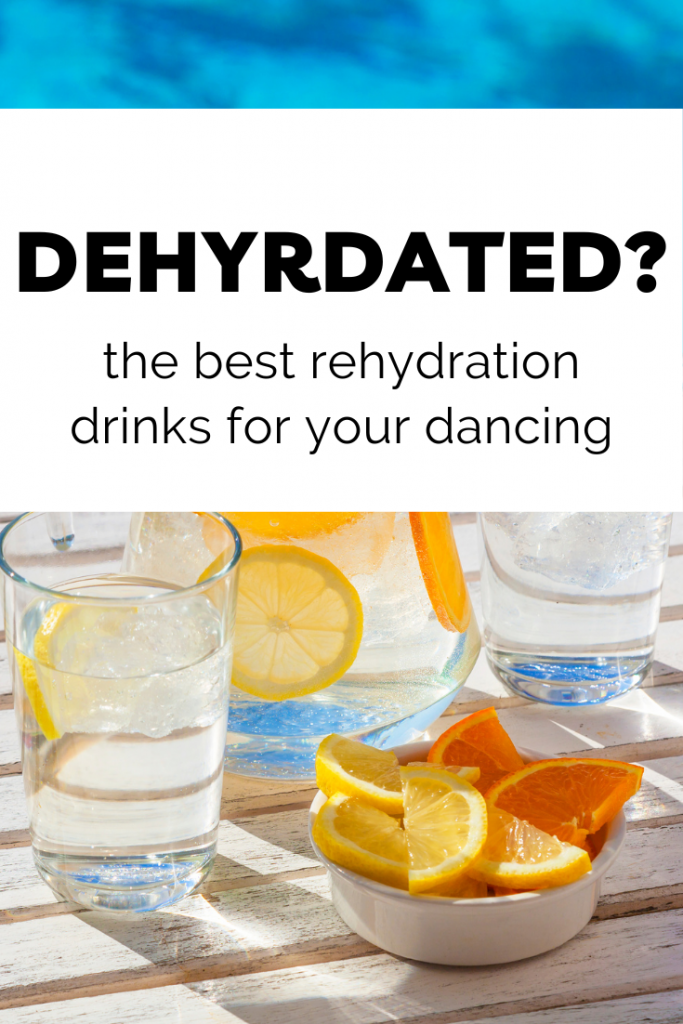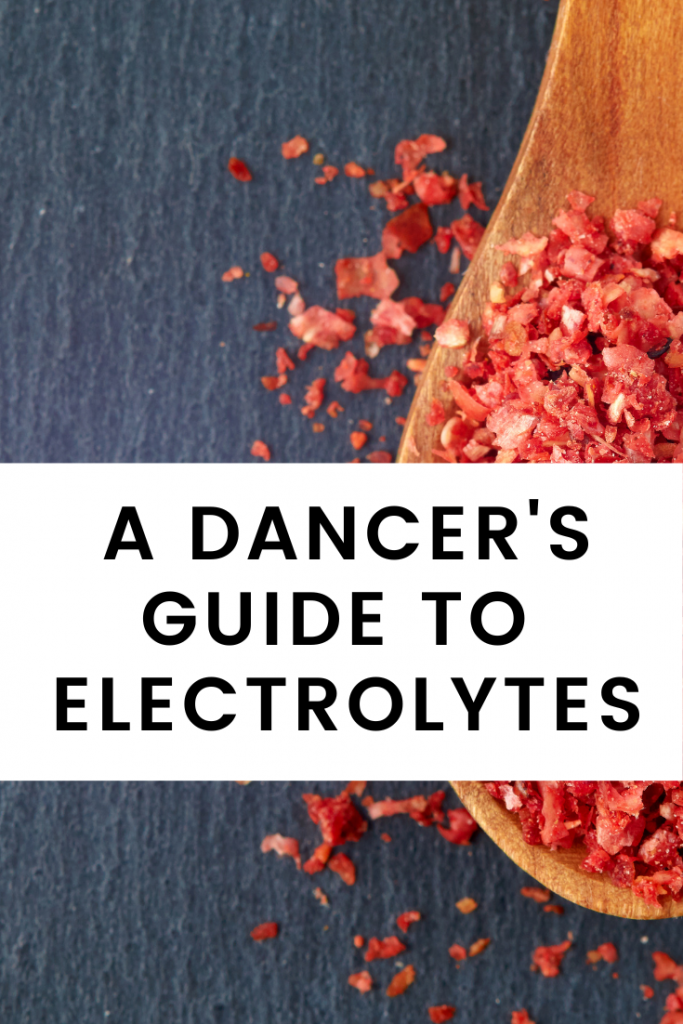Not drinking enough fluids— especially during the hot and humid summer months— can impact everything from stamina to flexibility. For pre-professional and professional dancers, a planned hydration strategy isn’t just helpful; it’s essential. While everyday hydration is covered in this guide, this post dives deeper into rehydration therapy: when dancers need electrolytes, what types are best, and how to choose the right supplement for your schedule and sweat rate.
When Is Rehydration Therapy Necessary for Dancers?
Rehydration therapy goes beyond just water. It means restoring lost fluids and electrolytes— specifically sodium, potassium, and chloride— after prolonged or intense movement. The goal is to maintain fluid balance, prevent muscle cramps, and support performance when food or snacks aren’t readily available.
When plain water is enough:
If you’re dancing less than 60 minutes per day, and you’re eating regularly balanced meals and snacks, then plain water is likely sufficient. This is especially true if your meals are rich in:
- Carbohydrates (grains, fruits, starchy veggies)
- Protein (eggs, dairy, meat, legumes)
- Fats (nuts, seeds, avocado)
- Micronutrients from fruits and vegetables
If you don’t love plain water, coconut water offers a naturally sweet, palatable option— great after short but strenuous activity.
When Dancers Need Electrolytes:
Dancers training or performing for 90 minutes or more, especially in hot environments, will benefit from additional electrolyte support. This includes:
- Summer intensives
- Multi-hour rehearsals
- Back-to-back classes
- Onstage performances without snack breaks
Sweat increases fluid loss, particularly sodium, making electrolyte replacement vital for sustained energy and recovery.
Will Electrolytes Help with Muscle Cramps?
While low potassium has historically been linked to cramping, dancers lose far more sodium than potassium through sweat. Research doesn’t strongly support the idea that potassium deficiency alone causes cramps. That means:
- Bananas and coconut water can help replenish modest potassium losses.
- Sodium remains the most important electrolyte to replete.
- High-dose potassium supplements are not necessary and can even be harmful.
Understanding Electrolytes for Dancers
Electrolytes are minerals that help regulate fluid balance, nerve function, and muscle contractions. The most relevant for dancers include:
- Sodium helps retain water and prevent dehydration
- Potassium supports muscle function
- Chloride works with sodium to maintain fluid balance
Why Sugar Matters, Too
While sugar is not required to replenish electrolytes, it can:
- Improve taste, encouraging higher fluid intake
- Restore blood glucose (this helps to prevent lightheadedness)
- Replenish glycogen (stored energy) when post-performance snacks are unavailable
- Enhance sodium and water absorption
This makes sweetened electrolyte drinks ideal for dancers who cannot access post-performance snacks or are dancing through long rehearsals or shows. If you’re struggling to understand the benefit of sugar here, read this article.
What to Look for in a Rehydration Drink
Based on guidelines from the Institute of Medicine, your 16-fluid-ounce drink should ideally include sodium (the most abundant mineral lost through sweat) and potassium (the second most abundant mineral lost through sweat).
Ingredient Ideal Range
- Sodium 218–326 mg
- Potassium 37–92 mg
- Carbohydrates (sweeteners like glucose ): 5-10% in concentration or about 23-45 grams
Best Electrolyte Drinks for Dancers (Ranked)
Here’s a breakdown of the most common rehydration options—ranked by effectiveness, convenience, and cost:
🥇 Powerade
- Pros: High in sodium chloride (great for rehydration), high in sugar (ideal when dancing without food access), affordable when compared to most other brands, beneficial for those with performance anxiety, as drinking might be easier to stomach mid-show than eating.
- Best for: Long rehearsals, performances, dancers with performance anxiety who can’t eat mid-show.
🥈 Pedialyte & Liquid I.V.
- Pros: Balanced electrolytes (including sodium, potassium, chloride), moderate sugar content.
- Best for: Summer intensives, heavy sweaters, moderate-length rehearsals.
🥉 Gatorade Zero & Nuun
- Pros: Lower in sugar, good for dancers managing blood sugar or limiting added sugars.
- Cons: Minimal chloride (minimal amount of chloride might not be a concern since chloride deficiency is rare); sugar-free options often include sugar alcohols or artificial sweeteners, which can cause bloating, cramping, and GI upset during performance.
- Best for: Short sessions with a snack on hand (e.g., pretzels or crackers).
🥥 Coconut Water
- Pros: Naturally rich in potassium (~800 mg per 16 oz), contains natural sugar, refreshing taste.
- Cons: more comparable to plain water given its low sodium content (~100 mg per 16-oz), limited rehydration support for heavy sweating.
- Best for: Light rehearsals, dancers sweating minimally, those who dislike artificial flavors.
- Pro Tip: If you’re drinking coconut water during long classes, pair it with a salty snack (such as Goldfish crackers, pretzels, or salted crackers) to boost your sodium intake.
Can I Make My Own Electrolyte Drink?
Absolutely! DIY rehydration therapy is affordable, customizable, and delicious. Just be mindful to include sodium, potassium, and carbohydrates in proportions that support absorption and fluid balance.
The Healthy Dancer® Homemade Electrolyte Booster
Start with this base, then choose a flavoring option from the list below.
Base Recipe (1 Serving):
- 1 cup water
- 6 oz coconut water
- ⅛ tsp salt (290 mg sodium, if you’re a heavy sweater, increase to ¼ tsp salt for up to 580 mg sodium)
- 1 tbsp cane sugar
Flavoring Options:
- Fresh lemon juice (3–4 lemons) + mint
- Fresh orange juice (3–4 oranges)
- Crushed berries (let steep overnight for flavor infusion)
Key Takeaways: Smart Rehydration for Dancers
Dancers need more than just water to thrive, especially in high-heat, high-intensity environments. Electrolyte support can:
- Reduce fatigue
- Improve focus and stamina
- Support recovery
- Prevent dizziness and cramps
The key? Choose your rehydration strategy based on how long you’re dancing, how much you’re sweating, and what food access you have during or after class.




